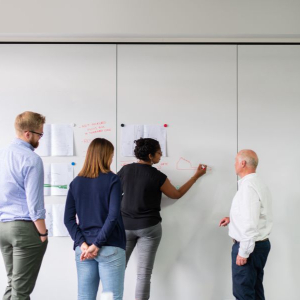Face to face / Online public schedule & onsite training. Restaurant lunch included at STL venues.
From £495 List price £650
This one-day course is tailored for professionals across various sectors who aim to enhance their facilitation capabilities, whether they are new to the role or seeking to refine their skills. It is ideal for anyone involved in running meetings or workshops.

Introduction to Facilitation
Overview of facilitation, its significance in business, and the roles of a facilitator.
Core Skills of a Facilitator
Developing key communication skills such as active listening, clarity in communication, and constructive feedback.
Techniques to foster open dialogue and manage group dynamics effectively.
Practical Application
Interactive scenarios to practice starting sessions, focusing discussions, and driving group participation.
Real-time feedback on facilitation techniques with a focus on adjustment and improvement.
Designing and Leading Workshops
Structuring sessions that engage and motivate participants.
Strategies to ensure inclusivity and participation from all attendees.
Handling Challenges in Facilitation
Techniques to address and resolve conflict, manage difficult participants, and overcome common facilitation barriers.
Creating conditions for effective brainstorming and decision-making.
Developing a Facilitator's Toolkit
Constructing action plans and facilitation agendas tailored to specific organisational needs.
Utilising tools and techniques learned throughout the day in a culminating practice session.
Debrief and Feedback
Open discussion to reflect on the day’s learnings and how they can be applied moving forward.
Arguably, the most experienced and highest motivated trainers.
Training is held in our modern, comfortable, air-conditioned suites.
A hot lunch is provided at local restaurants near our venues:
Courses start at 9:30am.
Please aim to be with us for 9:15am.
Browse the sample menus and view joining information (how to get to our venues).
Available throughout the day:
Regular breaks throughout the day.
Contains unit objectives, exercises and space to write notes
Your questions answered on our support forum.
|
|
| Next date | Location | Price |
|---|---|---|
| Fri 20 Feb | Limehouse | £495 |
| Tue 24 Feb | Online | £495 |
| Mon 23 Mar | Bloomsbury | £495 |
| Thu 26 Mar | Online | £495 |
| Wed 22 Apr | Limehouse | £495 |
| Thu 23 Apr | Online | £495 |
And 26 more dates...
Loading content...

![]()
![]()
![]()
![]()
![]() Excellent
Excellent
FMB Oxford Ltd
Ray P
Introduction to Management
"I have found this training course an inspiration and I know it will be a real benefit to me in my working and personal life."
Tutorials and discussions on MS Office
MS Office tips to save you time
MS Office shortcut keys for all versions
Handy info on industry trends
Latest news & offers
Loading content...
Below are some extracts from our Facilitation Skills – Level 1 manual.
Facilitation
Skills
Navigating Effective Group Processes
Introduction to Facilitation
Facilitation is the art and science of guiding groups toward
achieving their goals. Whether it’s a team meeting, a workshop, or a strategic
planning session, a skilled facilitator plays a crucial role in creating a
productive and collaborative environment. Here’s what you need to know:
Overview and Significance
Core Skills of a Facilitator
Practical Application
Designing and Leading Workshops
Remember, facilitation is both an art and a skill—one that
improves with practice. As you develop your facilitation abilities, pay
attention to group dynamics, adapt to different contexts, and foster
collaboration.
Handling Challenges in Facilitation
1. Conflict Resolution Techniques:
2. Managing Difficult Participants:
3. Overcoming Common Facilitation Barriers:
Creating Conditions for Effective Brainstorming and
Decision-Making
Developing a Facilitator’s Toolkit
Feedback Loop: Continuous
Improvement
Feedback is the fuel for growth. As a facilitator,
seek feedback from both participants and fellow facilitators:
Call for assistance
We will call you back